When the repair begins in the apartment, regardless of, what kind of room is subject to change, We should think about, how to lay tile on the walls and floor. This is especially true of the rules tile establishments in the corners, To preserve the appearance and attractiveness of the entire room. For this there are several options, the consequences of the preparatory work.
preliminaries
Before, how to make tile angle, should consider themselves careful preparation of walls and floors.
- They are pre-aligned, that did not happen with flaking material for a short time.
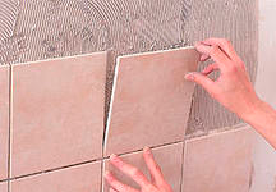
- Another possible defect ceramic tiles on uneven grounds - poorly formed inside or outside corner.
- Besides, surface at the time of application must be not only dry, but clean.
- It is important to check horizontal floor, vertical wall. This is done after, as an old coating removed.
- If we are talking about a wall, then use a plumb line in the form of the option selected goods, mountable on a thread.
To measure the angle may be used a large number of tools:
- For horizontality applicable building or water level. Everything will depend on the preferences of the Executive.
- There are laser level, but its cost is very high, to use disposable paper.
If the work will not be carried out before tiling, later in the corners will be formed gaps, spoiling the whole picture.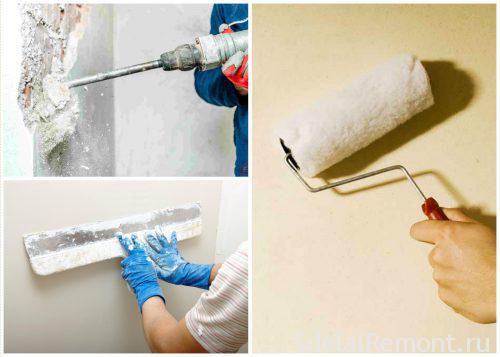
On the cleaned surface is first applied as a waterproofing layer of mastic lubricative, then - a primer. In the presence of even minor defects originally worth their repaired with putty. To create a smooth surface on the subfloor is filled:
- Cement-sand screed;
- Self-leveling.
You can not then forget about waterproofing and primer.
Tools and materials
In carrying out work on the walls and floor tiles in the room, little will the material itself. And also need the following list of:
- Special adhesive (if carried out laying tile in the corners in rooms with high humidity, such as bathroom, optional water-repellant adhesive).
- Spatula with teeth.
- crosses, allowing properly and smoothly join elements of the tiles to each other. Their thickness is chosen individually according to the distance being created.
- Finishing profile (eg, plastic or ceramic corner).
- Building level for even distribution on the surface of the tiles, and Tile, needed to produce smooth angles, both external, and internal.
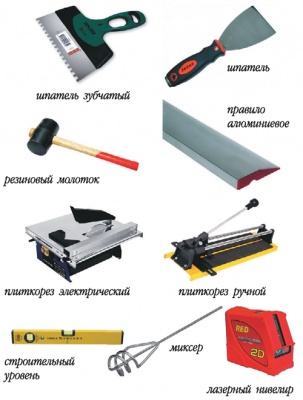
It is also important at this stage to know the exact number of tiles, required for. When this is taken into account the seam between tiles elements, which is typically 3-5 mm, determined by the "red" place (in sight), to which increased requirements because of the constant attention from the entrance.
Making the internal angle
If you want to work with angles on the walls, then everything should start with "red" seats. There are some nuances: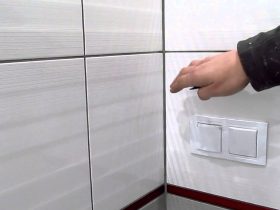
- Laying tiles It should be carried out with the adjacent sides and strictly symmetrical.
- If you use tile trim, they must be identical in size and parameters.
- When using a special tile cutter, then it already has this feature, how to determine the exact distance for cutting tiles. If the tool is not available, you will have to calculate everything yourself.
stages of work
- The beginning of the work is done from the floor in the room. Initially, the wall is applied to the selected option adhesive, takes approximately 1 square meter. Special spatula will help distribute it evenly over the entire surface.
- Glued tiles one by one.
- Achieve a smooth seam in various ways, one of which - to insert special crosses.
- When ready the first row, it should be checked using a spirit level. Thus when joining opposite wall, Tiles made of the segment to the desired length, after which it mounted to the wall.

At the beginning of laying tile on the wall of the adjacent tiles can be used with the rest of the first row. Be problematic choose the correct image. The main requirement is to combine them with each other, not forgetting tile seam at the junction. If the gap remains in 2 mm after laying tiles overlap, We get a sense of curvature. Maintain the attractiveness and appearance.
Applying Trim
The outer or inner corner of the tile can be done qualitatively using decorative profile, known as Trim. 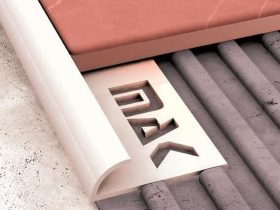 He was selected on the basis of colors tiles. It may be made of plastic or metal (metal corners for tiles).
He was selected on the basis of colors tiles. It may be made of plastic or metal (metal corners for tiles).
- If you performed outside corner, must be purchased L-shaped Trim
- Internal - Trim concave arc.
The latter option is often still used in the transition from the wall to the floor (plinth). Their field of application is very wide. The main thing to choose the right fit for execution.
In addition to its primary function, Trim may be protected against external mechanical action. 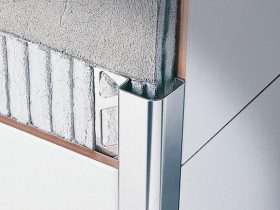 Consequently, life time laid tiles increase slightly. Work is carried out very simply, without special knowledge and special equipment.
Consequently, life time laid tiles increase slightly. Work is carried out very simply, without special knowledge and special equipment.
Sealant may be used for gluing the profile of silicone or acrylic-based. Also, any suitable adhesive is excellent for this type of work, as well as liquid nails.
It is worth noting, what Bathroom is especially performing outer corner. It is best to do seamless tiles, rather than choose from the remaining fragments.
facing
To run this version of the docking tiles in corners of the room, should acquire special equipment for work. The process of implementation will take some time and effort, which suggests the need for experience.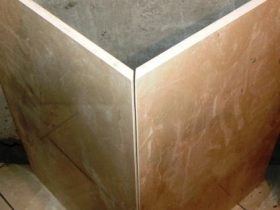
- At the attachment points of rings adjacent walls made undercut end part with an angle of 45 degrees.
- If in the future to connect two tiles with each other, angle must turn in 90 degrees. In this decorative piece tile looking at each other.
This operation is performed using electric Tile, equipped with a diamond disk, sandpaper or grinder. Each option has its own characteristics and complexity of the, which is worth reading more. The method may be used not only to create the interior angles between adjacent walls, but at tiling the external angle (in the door and window openings).
Use sandpaper to be correctly. It's not every option is suitable for her performance of works. The process should be bought at least two of its species:
- №40 and №60.
- №40 and №80.
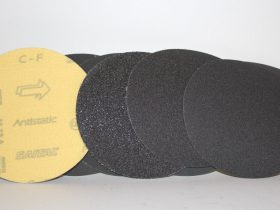 №40 suitable when used for coarse adjustment, and the second option is great cope with the precise alignment of the surface and eliminate the possibility of a defect.
№40 suitable when used for coarse adjustment, and the second option is great cope with the precise alignment of the surface and eliminate the possibility of a defect.
When the cutting end of the first, it is best to first take unwanted parts and they spend training. When all start getting well, We proceed to substantive work.
If there is no desire to perform such manipulations, Tiles can be purchased without corners. This is a separate type of decorative finish.
The elimination of defects
In the moment of work Education is not uncommon errors. From this no one is immune, but everyone should know about, how to get rid of them.
maybe, get uneven joint walls in room. To resolve this, you can simply adjust the number of kleivsheyusya mass under tiles. 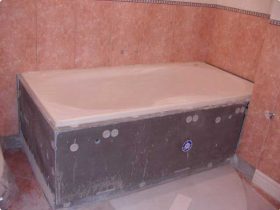 There is a uniform distribution under its entire surface.
There is a uniform distribution under its entire surface.
Not rare, when cutting tiles at an angle not brought the desired result. Formed slightly different angle, but not 45. In this case, the hands should take the sandpaper and it has to finish the job. the main thing, do not overdo it.
Problems at the junction of tiles the most common. To solve this problem is applied in practice are two basic ways:
- Processing classical grouting existing seams between adjacent walls.
- Installation of decorative profiles in the places of occurrence of chips and gaps material. Besides producing gluing profile very easily and quickly with a special sealant or liquid nails.
helpful hints
During the preparatory activities and the purchase of necessary materials should be carefully considered the available range. This is especially true in practice applied profiles. Their use may be associated with the creation of external and internal corners, depending on the destination. When it comes to the selection of colors, it is best to shop tiles and profile on the same network. This will give the best final results.
If you do everything right and choose the appropriate option docking tile elements, do not spoil the interior, and will appeal the entire room. Using the optional profiles of different materials for finishing the tile angles allow to hide any defects of this work, and fasten adjacent rows of tiles interconnected.
Article written for https://sdelalremont.ru.












